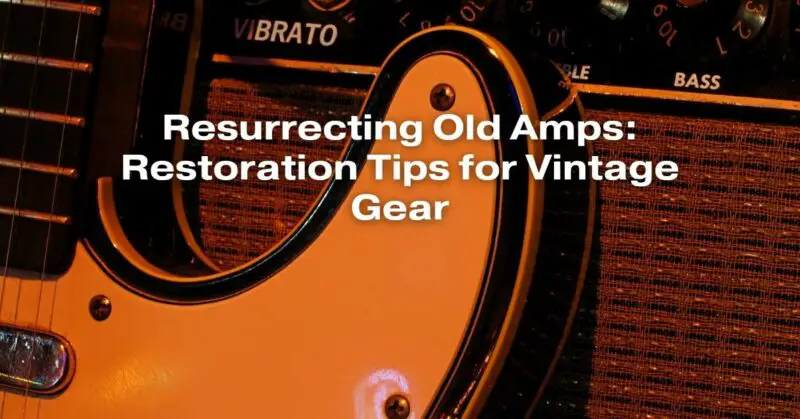In the world of audio enthusiasts and musicians, vintage amplifiers hold a special place. These classic pieces of gear have a unique charm and character that modern counterparts often struggle to replicate. Whether you’ve stumbled upon a forgotten gem in your attic or scored a vintage amplifier at a garage sale, the prospect of restoring an old amp can be an exciting and rewarding endeavor. However, bringing these relics back to life requires care, patience, and some technical know-how. In this comprehensive guide, we’ll explore the art of resurrecting old amps, providing restoration tips and insights for enthusiasts and beginners alike.
Understanding the Appeal of Vintage Amps
Before delving into the restoration process, it’s essential to appreciate why vintage amplifiers are so coveted. Vintage amps, typically produced in the mid-20th century, are cherished for their unique tonal qualities, craftsmanship, and nostalgia. These amps often feature point-to-point wiring, tube-based circuitry, and other components that impart a warm, rich, and distinct sonic character. Musicians, audiophiles, and collectors seek out vintage amps not just for their performance but for the piece of history they represent.
The Restoration Process
Restoring a vintage amp is a labor of love, and it’s crucial to proceed with care to ensure you maintain the amp’s authenticity and functionality. Here are the key steps involved in the restoration process:
1. Research and Documentation
Before diving into restoration, gather as much information as possible about your vintage amplifier. This includes its make, model, year of manufacture, and any known issues or modifications. Online forums, vintage gear communities, and manufacturer archives can be valuable resources for historical context and schematics.
2. Visual Inspection
Begin by inspecting the amplifier’s exterior and interior. Look for any visible damage, rust, or corrosion on the chassis, knobs, and connectors. Open the amp’s housing and examine the circuit boards, tubes, and wiring for signs of wear, damage, or loose connections.
3. Cleaning and Maintenance
A thorough cleaning is essential for vintage amps. Use a mild electronic cleaner to remove dust and grime from the chassis, knobs, and switches. Carefully clean the tube pins and connectors, ensuring a secure and clean electrical connection. Replace any damaged or corroded components like capacitors, resistors, and potentiometers.
4. Tube Replacement
Tubes are a critical component of vintage amplifiers, and they degrade over time. Testing and, if necessary, replacing tubes is a fundamental step in the restoration process. Consult the manufacturer’s specifications for the correct tube types and bias settings. It’s advisable to use high-quality, matched tubes for optimal performance.
5. Circuit Analysis and Repair
Understanding the amplifier’s circuitry is vital for effective restoration. If you lack the technical expertise, consider seeking assistance from a professional amplifier technician. Repair or replace damaged components and reflow solder joints as needed. Ensure that the amp’s grounding is proper to minimize noise and safety concerns.
6. Calibration and Biasing
Once the components are in place, calibrate and bias the amplifier according to the manufacturer’s specifications. This step is critical for achieving the desired tone and preventing premature wear on the tubes.
7. Testing and Troubleshooting
Before powering up the amp, double-check all connections and components. When turning the amp on for the first time after restoration, use a variac to gradually apply voltage and monitor for any anomalies or excessive current draw. Test the amp with a known source to verify its functionality, and address any issues that arise.
8. Cosmetic Restoration
If desired, you can also perform cosmetic restoration work. This may involve repainting the chassis, re-screen printing labels, or sourcing vintage-style components to maintain the amp’s original appearance.
Safety Considerations
Working with vintage amplifiers involves handling high-voltage components, which can be dangerous if mishandled. Here are some safety precautions to keep in mind:
Always discharge filter capacitors before touching any internal components.
Disconnect the amp from the power source when working on it.
Use appropriate safety gear, including gloves and safety goggles.
If you’re unsure about any aspect of the restoration process, consult with an experienced technician or seek professional help.
Conclusion
Restoring vintage amplifiers is a fascinating journey that combines technical skills with a passion for preserving the past. Whether you’re a musician seeking that classic tone or a collector preserving a piece of history, the restoration process can be immensely rewarding. Remember that each vintage amp has its unique characteristics, and maintaining its authenticity is part of the appeal.
While the steps outlined in this guide provide a general overview of the restoration process, it’s essential to adapt them to the specific needs and condition of your vintage amplifier. If you approach the task with patience, respect for the equipment, and a willingness to learn, you’ll be well on your way to bringing that old amp back to life and enjoying its timeless sound for years to come.


